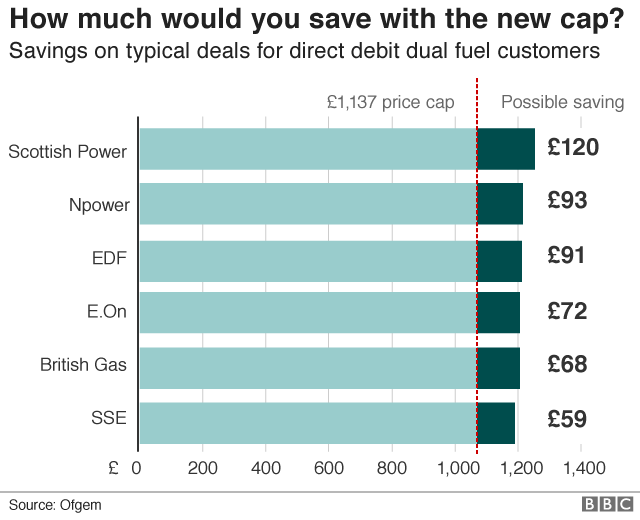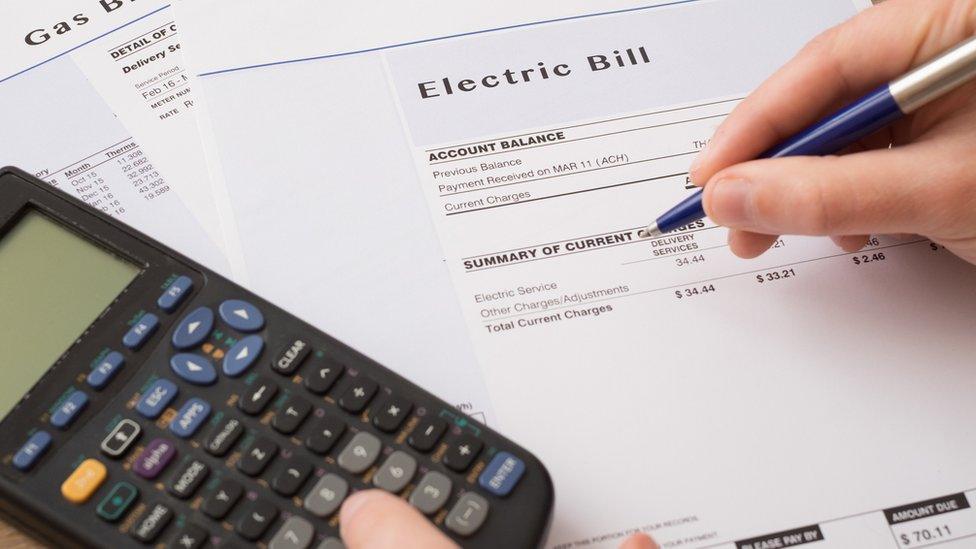Energy bills to be capped in new year
- Published
- comments
Price cap will be good deal for customers, says Ofgem boss
The new energy price cap will come into force on 1 January, saving 11 million customers an average of £76 a year on their gas and electricity bills.
Regulator Ofgem has set the final level of the cap at £1,137 a year for an average dual fuel customer who pays by direct debit.
It means suppliers will have to cut the price of their default tariffs to the level of the cap or below it.
But Ofgem said the cap could rise in April 2019, reducing the annual saving.
Who will benefit?
Households in England, Scotland and Wales on default tariffs - such as standard variable tariffs - should be better off after the cap is introduced. Consumers in Northern Ireland have a separate energy regulator and already have a price cap.
More than half of all households in Britain are on default tariffs because they have never switched or have not done so recently.
Five million customers who have pre-payment meters, or are judged to be vulnerable, already have their energy costs capped.
The government introduced legislation earlier this year to establish the price cap following concerns about how efficiently the energy market was working.
How much will households save?
How much you save will depend on how much energy you use, which tariff you are on, if you have both gas and electricity, and how you pay for your energy.
The cap is per unit of energy, not on the total bill. So people who use more energy will still pay more than those who use less.
Households using a typical amount of gas and electricity will save about £76 on average, while those on the most expensive tariffs will save about £120.

But experts say households could still save more money if they switch supplier, and take out a fixed price tariff. Savings of up to £285 a year are possible, according to the government.
"While the price cap will ease the financial burden for some households, people shouldn't be lulled into a false sense of security that it will mean they are getting the best deal," said Alex Neill of Which?
"Switching is still the best way to save money on your energy bills."
What will happen to the cap next year?
Ofgem will review the tariff in February, and then adjust it in April and October each year. It has said that the level of the cap is likely to rise in April 2019, to reflect the higher cost of wholesale energy. As a result, the average annual saving in 2019 is likely to be lower than £76.
"Unfortunately, any joy that long-suffering households feel today is likely to be short-lived," said Stephen Murray, energy expert at MoneySupermarket.
"Ofgem is attempting to protect consumers by launching this cap with a £76 savings message, but it's simply not sustainable. The cap will be reviewed again in February, when market forces look likely to dictate it will rise significantly."
Ofgem said that customers could be confident that any rise in the cap "would only reflect changes in the actual costs of providing the gas and electricity they use rather than supplier profiteering".

Will the cap lead to less switching?
Those who have argued against the introduction of a price cap have said it will be counter-productive, as it will lead to fewer people switching - where the potential savings are greater.
Ofgem has admitted that is a concern.
"It will probably lead to less switching," Dermot Nolan, the chief executive of Ofgem, told the BBC's Today programme.
"But if you choose not to switch you can still get a fair level of protection."
How long will the cap last?
The cap may not last long. Ofgem will review its effect on the energy market in 2020, and the secretary of state will then decide whether to extend it by another year.
What is actually being capped?
The cap is on the unit price of energy, and the standing charge.
So the cost of electricity - for those on default tariffs - will be capped at 17p per kWh. Gas will be capped at 4p per kWh.
Dual fuel users will pay no more than £177 a year for a standing charge; electricity-only users will pay no more than £83, and gas users £94.
- Published6 September 2018
